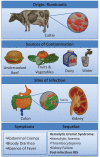Pathogenicity, host responses and implications for management of enterohemorrhagic Escherichia coli O157:H7 infection
- PMID: 23712303
- PMCID: PMC3735731
- DOI: 10.1155/2013/138673
Pathogenicity, host responses and implications for management of enterohemorrhagic Escherichia coli O157:H7 infection
Abstract
Enterohemorrhagic Escherichia coli serotype O157:H7 is a food- and waterborne pathogen that causes significant morbidity and mortality in both developing and industrialized nations. The present review focuses on the history, epidemiology and evolution of the pathogen; provides a mechanistic overview of major virulence factors (including Shiga toxins, locus of enterocyte effacement pathogenicity island and pO157 plasmid); discusses host immune responses to infection; considers available animal models; and provides an overview of current and potential future management considerations.
L’Escherichia coli de sérotype O157:H7 entérohémorragique est un pathogène d’origine alimentaire et hydrique qui provoque une morbidité et une mortalité considérables, tant dans les pays en développement que dans les pays industrialisés. La présente analyse s’attarde sur l’histoire, l’épidémiologie et l’évolution du pathogène, présente un aperçu mécaniste des principaux facteurs de virulence (y compris les toxines Shiga, les îlots de pathogénicité du locus d’effacement des entérocytes et le plasmide pO157), aborde les réponses immunitaires de l’hôte à l’infection, traite des modèles animaux disponibles et contient un aperçu de la prise en charge actuelle et éventuelle.
Figures
References
-
- Kaper JB, Nataro JP, Mobley HL. Pathogenic Escherichia coli. Nat Rev Microbiol. 2004;2:123–40. - PubMed
-
- Croxen MA, Finlay BB. Molecular mechanisms of Escherichia coli pathogenicity. Nat Rev Microbiol. 2010;8:26–38. - PubMed
-
- Riley LW, Remis RS, Helgerson SD, et al. Hemorrhagic colitis associated with a rare Escherichia coli serotype. N Engl J Med. 1983;308:681–5. - PubMed
-
- Karmali MA, Petric M, Lim C, Fleming PC, Arbus GS, Lior H. The association between idiopathic hemolytic uremic syndrome and infection by verotoxin-producing Escherichia coli. J Infect Dis. 1985;151:775–82. - PubMed
-
- Levine MM. Escherichia coli that cause diarrhea: Enterotoxigenic, enteropathogenic, enteroinvasive, enterohemorrhagic, and enteroadherent. J Infect Dis. 1987;155:377–89. - PubMed
Publication types
MeSH terms
Substances
LinkOut - more resources
Full Text Sources
Other Literature Sources
Medical

